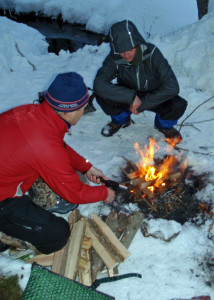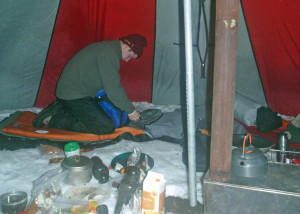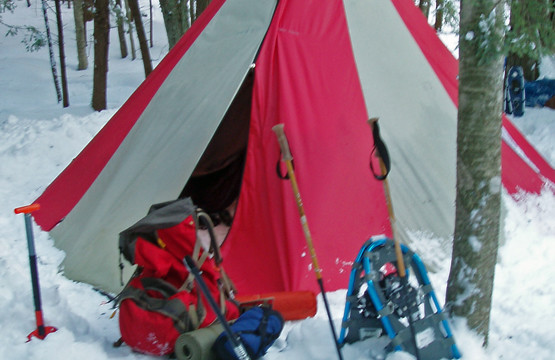
Many people go backpacking in the summer, some in the spring and fall, far fewer through the winter. That’s a shame because winter offers instant adventure to anyone bold enough to set up a tent or build a snow shelter and spend the night outdoors. There aren’t any bugs, it rarely rains. You enjoy quiet and solitude that you simply can’t find at other times of year. With modern camping gear, sleeping cozy, even in bitter cold, is not difficult. In fact, its part of the fun.
There are two types of winter camping: cold camping and warm camping. They aren’t as different as they might sound. . . .
Cold camping means camping without a heat source, relying on a tent or tarp to shelter you from wind and falling or drifting snow, and warm clothes and a good sleeping bag to keep you comfortable. Though “cold camping” doesn’t sound all that appealing, you can be surprisingly comfortable in a “cold” camp.
The big advantage of cold camping is that your pack is lighter and you are more mobile. Almost any trail you’d backpack on in the summer is fair game for a winter cold camping trek. With a free-standing tent, it’s easy to travel on snowshoes or skis, reach your destination and, an hour later, be well fed and snug in your sleeping bag for the night. The only moment of potential discomfort unique to cold camping is hauling yourself out of that cozy sleeping bag in the morning and breaking camp. But, if you planned it right, you’ve already had something warm and comforting to eat and drink before you have to get up and get dressed for the day.

Warm winter camping is something of a misnomer, since it isn’t warm all the time. You spend your days and nights in the same cold as cold campers. Typically, the only warm in warm winter camping is in the evenings and perhaps again in the morning when you are awake and in camp to tend to some sort heat source. That heat source might be a campfire in front of a tarp shelter, a woodstove inside a tent or even a candle lantern inside a snow cave or snow shelter—which can be surprisingly cozy. It would seem that gas-fueled catalytic heaters would be ideal inside a tent, but I’ve never found a stove/fuel combo that’s light and efficient enough to carry backpacking.
The advantage of warm camping is obvious—you aren’t confined to your sleeping bag when you aren’t moving. You get to dress and undress, eat and relax in a warmed space.
Warm camping also has its disadvantages. Warm setups are usually—but not always— heavier than cold camping. And it usually takes a lot more time to set up a tarp-and-campfire site or a woodstove-heated tent or to build a snow shelter than it does to pop up a free-standing tent. Then there’s the time and effort it takes to find wood for a campfire or stove—not always easy when the snow is deep.

Warm camping works better when you spend more than one night at a campsite rather than moving camp every day. A warm camp is perfect for a long weekend. Pack in and set up camp your first day, leaving plenty of time to find wood if needed. The following days you can explore out from there, knowing you can return to a snug haven.
Warm or cold, winter backpacking is something everyone should try at least twice. Why twice? Because the second try is almost always easier and more fun than the first.
Warm/Cold Winter Backpacking: The Most Common Mistakes
Warm or Cold, here are the most common mistakes winter campers make (I speak from experience—I’ve made them all . . .)
Mistake 1: Insufficient planning. Think carefully about every item of gear you take. Then make sure you take it! Unless you are super-organized, chances are you are going to forget something. Forgetting something important in the summer is inconvenient; in winter it can mean BIG trouble! Make a very detailed checklist and keep it handy. If you don’t have a checklist started, write to me and I’ll send you one, or you can go to EasternSlopes.com and search “checklist”.
Mistake 2: Overextending. Until you are experienced at winter camping, don’t try to go too far. Travel on snow is almost always slower and more arduous than on bare ground. It also takes longer to set up a camp on snow. So until you know what you can do, deliberately choose to go shorter rather than longer. On an untracked trail, three miles is about my personal limit.
Mistake 3: Not eating and drinking enough. Food is heavy to carry, often more difficult to prepare in cold weather. Water is hard to find and often freezes in winter–and getting up to pee in the night isn’t a lot of fun. So it’s tempting to eat and drink less than you need. Force yourself to eat high calorie foods and drink water (not alcohol or sugary drinks) constantly. The more solid fuel in your furnace and the more hydrated you are, the better your whole body will function in the cold.
Mistake 4: Not getting out. This is the worst mistake of all. Winter camping is fun, healthy, great exercise. Put on your pack and your snowshoes and try it.



[…] Tim’s article goes on to describe common mistakes made by winter campers. You can read it here. […]
[…] out of the project. If you’d like proof that I actually use it, check out the photo in the “Warm/Cold Winter Camping” […]
[…] This post was mentioned on Twitter by BackCountryEdge and Travel News Feeds, EasternSlopes. EasternSlopes said: New blog posting, Warm/Cold Winter Backpacking – http://tinyurl.com/yghkv48 […]
Great information, Tim. Thanks for this post. I’ve been thinking about trying winter camping, but have been intimidated thinking about the gear, preparation, and effort involved.
It doesn’t help that I live in Alaska, where winter temperatures can drop to -40 or colder. But the lure of getting out there remains. You make it sound like it’s worth it!
where is a good place to go winter camping? Been going in NC Mtns. for 8 yrs and want to go cold. 7 guys. 5 days include travel. ideas much appreciated.
Well, it was colder and snowier in North Carolina yesterday than it was up here in New England . . . that all changes tomorrow. . . .
We really need more information before we can start to answer your question. To get to anyplace significantly colder and snowier than your mountains, you are going to have to travel to New York or New England, and that means you pretty much lose a full day each way. . . . Are you thinking two, three or four nights of camping? Do you want to camp in one place and explore from there or do you want to move your camp to a new place each day?
When are you thinking of doing this? January offers different challenges than March . . .
Are you planning to use skis or snowshoes? Will you be carrying your gear in backpacks or on pulks? Do you plan to use tents, tarps, or established shelters or cabins? Are you looking for exposed alpine camping or woodland camping among lakes and rivers?
There are plenty of wonderful places to explore in winter: New York’s Adirondacks, Vermont’s Green Mountains, New Hampshire’s White Mountains and certain places in Maine’s western mountains, even across the border in Quebec. Once we get a clearer idea of what you are looking for, we can give you more specific suggestions. Some of our other readers might weigh in, too, based on their experience.
In any case, you are headed toward a memorable adventure. We’ll be happy to help you explore safely.